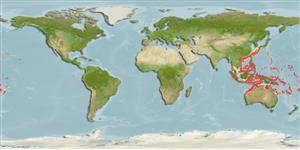>
Eupercaria/misc (Various families in series Eupercaria) >
Lutjanidae (Snappers) > Etelinae
Etymology: Pristipomoides: Greek, pristis = saw + Greek, poma, -atos = cover, operculum + Greek, oides = similar to (Ref. 45335).
More on author: Valenciennes.
Environment: milieu / climate zone / depth range / distribution range
Ökologie
seewasser riff-verbunden; tiefenbereich 70 - 350 m (Ref. 9821). Tropical; 35°N - 24°S, 98°E - 167°W (Ref. 55)
Indo-Pacific: East Africa to the Society Islands, north to southern Japan, south to New Caledonia.
Size / Gewicht / Alter
Maturity: Lm ? range ? - ? cm
Max length : 40.0 cm SL Männchen/unbestimmt; (Ref. 9821); common length : 25.0 cm SL Männchen/unbestimmt; (Ref. 9821)
Rückenflossenstacheln (insgesamt) : 10; Rückenflossenweichstrahlen (insgesamt) : 11; Afterflossenstacheln: 3; Afterflossenweichstrahlen: 8. Interorbital space slightly convex. Preorbital depth 7.0 to 8.0 times in head length. Pectoral fins long, reaching level of anus. Scale rows on back parallel to lateral line. The upper part of the head reddish; the back mainly yellow; the sides and belly silvery, sometimes pinkish; body with very many bright blue spots and vermiculations. The dorsal and caudal fins yellowish.
Adults are found over rocky bottoms. They feed on small fishes, crustaceans and squids.
Life cycle and mating behavior
Geschlechtsreife | Fortpflanzung | Ablaichen | Eier | Fecundity | Larven
Allen, G.R., 1985. FAO Species Catalogue. Vol. 6. Snappers of the world. An annotated and illustrated catalogue of lutjanid species known to date. FAO Fish. Synop. 125(6):208 p. Rome: FAO. (Ref. 55)
IUCN Rote Liste Status (Ref. 130435: Version 2024-2)
Bedrohung für Menschen
Harmless
Nutzung durch Menschen
Fischereien: weniger kommerziell
Tools
Zusatzinformationen
Download XML
Internet Quellen
Estimates based on models
Preferred temperature (Ref.
123201): 15.2 - 26.2, mean 20.4 °C (based on 252 cells).
Phylogenetic diversity index (Ref.
82804): PD
50 = 0.5005 [Uniqueness, from 0.5 = low to 2.0 = high].
Bayesian length-weight: a=0.01514 (0.00897 - 0.02555), b=3.00 (2.86 - 3.14), in cm total length, based on LWR estimates for this species & Genus-body shape (Ref.
93245).
Trophic level (Ref.
69278): 4.2 ±0.57 se; based on food items.
Widerstandsfähigkeit (Ref.
120179): mittel, Verdopplung der Population dauert 1,4 - 4,4 Jahre. (Preliminary K or Fecundity.).
Fishing Vulnerability (Ref.
59153): Moderate vulnerability (39 of 100).
Nutrients (Ref.
124155): Calcium = 40.7 [22.0, 71.5] mg/100g; Iron = 0.638 [0.331, 1.057] mg/100g; Protein = 18.9 [17.0, 20.7] %; Omega3 = 0.184 [0.114, 0.294] g/100g; Selenium = 46.9 [27.3, 85.5] μg/100g; VitaminA = 116 [42, 380] μg/100g; Zinc = 0.863 [0.599, 1.221] mg/100g (wet weight);
